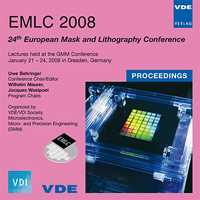CDO Budgeting
Konferenz: EMLC 2008 - 24th European Mask and Lithography Conference
21.01.2008 - 24.01.2008 in Dresden, Germany
Tagungsband: EMLC 2008
Seiten: 9Sprache: EnglischTyp: PDF
Persönliche VDE-Mitglieder erhalten auf diesen Artikel 10% Rabatt
Autoren:
Nesladek, Pavel; Wiswesser, Andreas; Sass, Björn; Mauermann, Sebastian (Advanced Mask Technology Center, Rähnitzer Allee 9; 01109 Dresden, Germany)
Inhalt:
The Critical dimension off-target (CDO) is a key parameter for mask house customer, affecting directly the performance of the mask. The CDO1 is the difference between the feature size target and the measured feature size. The change of CD during the process is either compensated within the process or by data correction. These compensation methods are commonly called process bias and data bias, respectively. The difference between data bias and process bias in manufacturing results in systematic CDO error, however, this systematic error does not take into account the instability of the process bias. This instability is a result of minor variations - instabilities of manufacturing processes and changes in materials and/or logistics. Using several masks the CDO of the manufacturing line can be estimated. For systematic investigation of the unit process contribution to CDO and analysis of the factors influencing the CDO contributors, a solid understanding of each unit process and huge number of masks is necessary. Rough identification of contributing processes and splitting of the final CDO variation between processes can be done with approx. 50 masks with identical design, material and process. Such amount of data allows us to identify the main contributors and estimate the effect of them by means of Analysis of variance (ANOVA) combined with multivariate analysis. The analysis does not provide information about the root cause of the variation within the particular unit process, however, it provides a good estimate of the impact of the process on the stability of the manufacturing line. Additionally this analysis can be used to identify possible interaction between processes, which cannot be investigated if only single processes are considered. Goal of this work is to evaluate limits for CDO budgeting models given by the precision and the number of measurements as well as partitioning the variation within the manufacturing process. The CDO variation splits according to the suggested model into contributions from particular processes or process groups. Last but not least the power of this method to determine the absolute strength of each parameter will be demonstrated. Identification of the root cause of this variation within the unit process itself is not scope of this work.


